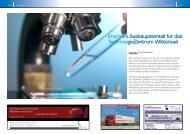New Tools for Protein Research Located in the TZW ... - TZW Witterswil
New Tools for Protein Research Located in the TZW ... - TZW Witterswil
New Tools for Protein Research Located in the TZW ... - TZW Witterswil
Erfolgreiche ePaper selbst erstellen
Machen Sie aus Ihren PDF Publikationen ein blätterbares Flipbook mit unserer einzigartigen Google optimierten e-Paper Software.
<strong>TZW</strong> Technologiezentrum <strong>Witterswil</strong> AG, CH-4108 <strong>Witterswil</strong>, Switzerland<br />
Covalys – <strong>New</strong> <strong>Tools</strong><br />
<strong>for</strong> <strong>Prote<strong>in</strong></strong> <strong>Research</strong><br />
<strong>Located</strong> <strong>in</strong> <strong>the</strong> <strong>TZW</strong> – <strong>the</strong> Life Sciences<br />
Technology Centre <strong>in</strong> <strong>Witterswil</strong><br />
Dr. Christoph Bieri, Covalys Biosciences AG, <strong>Witterswil</strong><br />
Covalys develops and commercializes consumables which facilitate<br />
research on prote<strong>in</strong>s. Our kits are used by scientists <strong>in</strong> universities<br />
and <strong>in</strong> <strong>in</strong>dustry (Pharma, Biotech). Founded <strong>in</strong> July 2002,<br />
Covalys launched its operations <strong>in</strong> November 2003 at <strong>the</strong> <strong>TZW</strong>,<br />
with <strong>the</strong> back<strong>in</strong>g of Swiss venture capitalists Venture Incubator<br />
AG, BVgroup Hold<strong>in</strong>g AG, Novartis Venture Fund, Erf<strong>in</strong>dungsVerwertungs<br />
AG and a private <strong>in</strong>vestor. As of August 2005,<br />
we employed 16 staff, <strong>the</strong>reof 11 PhDs.<br />
Covalys’ proprietary technology, <strong>the</strong> SNAP-tag, enables and facilitates<br />
a wide range of experimental procedures used to study<br />
prote<strong>in</strong>s, <strong>the</strong> “molecular motors of life”. In comb<strong>in</strong>ation with fluorescence<br />
microscopy, SNAP-tag can be used to see where a prote<strong>in</strong><br />
of <strong>in</strong>terest is localized with<strong>in</strong> a cell, and how it changes localization<br />
as a response to cellular processes. In biochemical<br />
assays, <strong>the</strong> <strong>in</strong>teraction parameters (aff<strong>in</strong>ity, speed etc.) of prote<strong>in</strong>s<br />
can be determ<strong>in</strong>ed. A SNAP-tag fusion prote<strong>in</strong> can be immobilized,<br />
without prior purification, <strong>in</strong> an oriented and covalent manner<br />
to biosensors (such as Biacore’s <strong>in</strong>struments) to study <strong>the</strong>ir<br />
<strong>in</strong>teraction with o<strong>the</strong>r molecules, e.g. potential new drugs. In proteomics,<br />
SNAP-tag fusions to a prote<strong>in</strong> can be used to per<strong>for</strong>m<br />
so-called “pull-down assays” with which prote<strong>in</strong> <strong>in</strong>teraction networks<br />
can be elucidated. All applications of SNAP-tag help to <strong>in</strong>vestigate<br />
<strong>the</strong> role of prote<strong>in</strong>s and <strong>the</strong>ir <strong>in</strong>teractions, build<strong>in</strong>g <strong>the</strong><br />
basis to understand <strong>the</strong> molecular causes of diseases, and to develop<br />
new medic<strong>in</strong>es.<br />
The SNAP-tag is itself a small prote<strong>in</strong> (26kD). It can be genetically<br />
l<strong>in</strong>ked to a prote<strong>in</strong> of <strong>in</strong>terest. The result<strong>in</strong>g “SNAP-tag fusion<br />
prote<strong>in</strong>” can <strong>the</strong>n be labeled with so-called SNAP-tag substrates<br />
which bear fluorophors or aff<strong>in</strong>ity probes, or can be<br />
specifically immobilized to surfaces which are coated by SNAPtag<br />
substrate. Label<strong>in</strong>g and immobilization, respectively, is covalent<br />
(hence <strong>the</strong> name of <strong>the</strong> company) and highly specific: Only<br />
<strong>the</strong> SNAP-tag fusion prote<strong>in</strong> is labeled or immobilized. The technology<br />
is protected by a group of patent applications which are<br />
owned by <strong>the</strong> Ecole Polytechnique Fédérale de Lausanne (EPFL)<br />
and exclusively licensed to Covalys. The <strong>in</strong>ventor of <strong>the</strong> SNAPtag<br />
technology, Prof. Kai Johnsson, is a co-founder of Covalys<br />
and a member of Covalys’ Board of Directors.<br />
Covalys offers “kits” which conta<strong>in</strong> all elements a scientist<br />
needs to use <strong>the</strong> SNAP-tag technology. Some kits conta<strong>in</strong> <strong>the</strong><br />
DNA of SNAP-tag which enables <strong>the</strong> customer to make a fusion<br />
to his or her prote<strong>in</strong> of <strong>in</strong>terest. O<strong>the</strong>r kits conta<strong>in</strong> substrates<br />
and small separation columns to remove unbound substrate<br />
after <strong>the</strong> reaction.<br />
Covalys Biosciences AG<br />
In its laboratories at <strong>the</strong> <strong>TZW</strong>, Covalys develops new applications<br />
and kits based on <strong>the</strong> SNAP-tag. There is a fully equipped chemical<br />
syn<strong>the</strong>sis laboratory with 2 PhDs and a technician, led by<br />
Maik K<strong>in</strong>dermann, Head of Chemistry. Three PhDs and two technicians<br />
work <strong>in</strong> our cell biology and biochemistry labs <strong>in</strong> product<br />
development under <strong>the</strong> supervision of Andreas Brecht, Chief<br />
Technology Officer. Two PhDs help Tom Gibbs, Covalys’ Head<br />
of Market<strong>in</strong>g and Support, to establish market<strong>in</strong>g materials, keep<br />
Concept of <strong>the</strong> SNAP-tag: The SNAP-tag (light-grey “doughnut”)<br />
is genetically fused to a prote<strong>in</strong> of <strong>in</strong>terest (dark grey globe).<br />
The SNAP-tag reacts with para-substituted benzyl guan<strong>in</strong>e,<br />
“snapp<strong>in</strong>g” <strong>the</strong> benzyl r<strong>in</strong>g with <strong>the</strong> label (light-grey star). The<br />
leav<strong>in</strong>g group is free guan<strong>in</strong>e. Us<strong>in</strong>g <strong>the</strong> SNAP-tag, prote<strong>in</strong>s can be<br />
specifically and covalently labeled with any chemical compound.<br />
SWISS BIOTECH 24 (2006) Nr. 1 11



